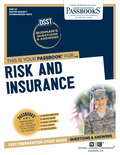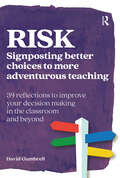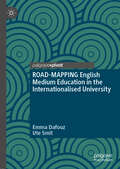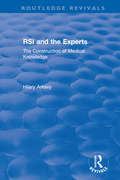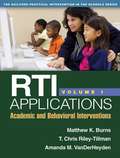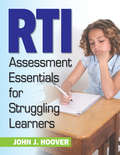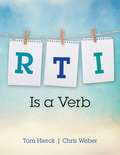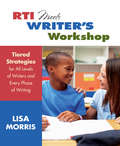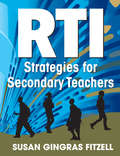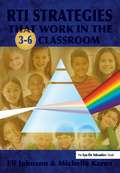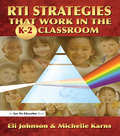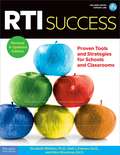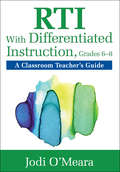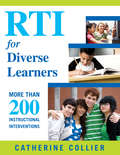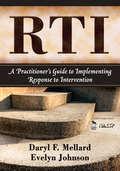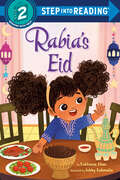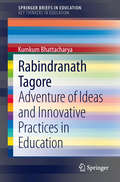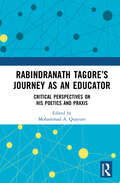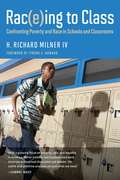- Table View
- List View
RIGOR Unveiled: A Video-Enhanced Flipbook to Promote Teacher Expertise in Relationship Building, Instruction, Goals, Organization, and Relevance
by James Marshall Douglas Fisher Nancy FreyA professional development assessment tool to elevate learning and instruction in every classroom This unique, hands-on flipbook is designed as a classroom observation tool that redefines RIGOR, with a focus on five key elements, or indicators, that form a framework to promote a rigorous, scaffolded learning environment. Explore the five indicators on a RIGOR Walk to identify teacher strengths and areas for growth, and to set goals: Relationships Instruction Goals Organization Relevance Developed for teachers, teams, instructional coaches, and school leaders, RIGOR Unveiled provides a wealth of support and knowledge for classroom observation and reflection, including: Tabbed sections that describe each of the five indicators to help focus discussion and evaluations Rubrics for evaluation including ratings, evidence, and "My Next Steps" 100+ video spotlights defining key concepts 25 classroom videos showing each of the indicators in action 25 videos of coaches discussing what they observed in each of the classroom videos Sturdy flipbook format for individual and team use and easy writing on the go Spot It Happening feature to calibrate observations as they happen Together your teaching teams can improve the learning outcomes for students by committing to continuous improvement in their teaching practice. With this book in hand, you’ll have everything you need to make it happen.
RISK AND INSURANCE: Passbooks Study Guide (DANTES Subject Standardized Tests (DSST))
by National Learning CorporationThe DSST Subject Standardized Tests are comprehensive college and graduate level examinations given by the Armed Forces, colleges and graduate schools. These exams enable students to earn college credit for what they have learned through self-study, on the job, or by other non-traditional means. The DSST Risk and Insurance Passbook® prepares candidates for the DSST exam, which enables schools to award credit for knowledge acquired outside the normal classroom environment. It provides a series of informational texts as well as hundreds of questions and answers in the areas that will likely be covered on your upcoming exam.
RISK: Signposting better choices to more adventurous teaching (Practical Teaching)
by David Gumbrell39 reflections to improve your decision making in the classroom and beyond.Go on! You can do it!Are teachers becoming ever more compliant as a profession? By just quietly getting on with things there is a danger of losing that spark that attracted you to your career in the first place. However, if you feel empowered to take more risks - to take back control of how you teach - then you have the chance to reignite your passion for the job.This book follows on from David Gumbrell’s text LIFT!, arguing that when you are feeling more resilient you have the courage and confidence to take more risks. You can also calculate that risk more rationally, thereby making it less risky and more likely to result in success. As this cycle continues you become more invigorated, more inspired and thus more engaging as a teacher.A beautifully written book with David's characteristic use of rich metaphors and thoughtful narrative. This book will certainly help you make bolder and better decisions in the classroom and beyond. Adrian Bethune.
ROAD-MAPPING English Medium Education in the Internationalised University
by Emma Dafouz Ute SmitThis book is the first to offer a conceptual framework of English-medium education that can be used across different international higher education (HE) contexts. It provides readers with an understanding of the complexities, possibilities and challenges that this phenomenon raises in the 21st century. Making the case for the pressing need for an overarching conceptualisation, the authors discuss, from a theoretical point of view, the recently introduced ROAD-MAPPING framework for ‘English Medium Education in Multilingual University Settings’ (EMEMUS). Drawing on current research and examples from a variety of settings, the book makes a strong case for the applicability of the framework in two important directions: as a methodological tool for researching educational practices and as an analytical guide to examine policies and teacher education programmes.
RPWD Act - Hindi-2016: आरपीडब्ल्यूडी ॲक्ट - हिंदी-2016
by Rpwd Actदिव्यांगजनों के अधिकारों पर संयुक्त राष्ट्र अभिसमय और उससे संबंधित या उसके आनुषंगिक विषयों को प्रभावी बनाने के लिए अधिनियम दिए गए है। संयुक्त राष्ट्र महासभा ने, 13 दिसम्बर, 2006 को दिव्यांगजनों के अधिकारों पर उसके अभिसमय को अंगीकृत किया था, और पूर्वोक्त अभिसमय दिव्यांगजनों के सशक्तिकरण के लिए सिद्धांत अधिकथित करता है।
RSI and the Experts: The Construction of Medical Knowledge (Routledge Revivals)
by Hilary ArkseyFirst published in 1998, RSI and the Experts explores the interactions and negotiations that take place between experts and lay groups in the evolution of medical scientific knowledge, concentrating on Repetitive Strain Injury (RSI). The book poses questions as to how medical knowledge is developed and what power structures are involved, drawing on evidence collected from a variety of stakeholders, including people with RSI, doctors, and ergonomists. It informs contemporary debates in the sociology of scientific knowledge and explores the practical implications of lay intervention, bridging sociological theory, medical science policy and activist concerns.
RTI Applications, Volume 1: Academic and Behavioral Interventions (The Guilford Practical Intervention in the Schools Series #1)
by Matthew K. Burns T. Chris Riley-Tillman Amanda M. VanDerHeydenThis book addresses a crucial aspect of sustaining a response-to-intervention (RTI) framework in a school: selecting interventions with the greatest likelihood of success and implementing them with integrity. Leading RTI experts explain how to match interventions to students' proficiency levels, drawing on cutting-edge research about the stages of learning. Effective academic and behavioral interventions for all three tiers of RTI are described in step-by-step detail and illustrated with vivid case examples. In a large-size format with lay-flat binding for easy photocopying, the book features more than 40 reproducible planning tools and other helpful forms. Purchasers also get access to a Web page where they can download and print the reproducible materials.
RTI Assessment Essentials for Struggling Learners
by John J. HooverCovering universal screening, progress monitoring, and diagnostic assessment for special education, this resource presents a comprehensive overview of assessment for struggling students within RTI.
RTI Is a Verb
by Tom Hierck Christopher A. WeberRTI is more than just a buzzword—it’s a success story! RTI isn’t just about interventions—it’s about assessing how all students respond to instruction. Here, you’ll learn to translate RTI from research to practice and build a realistic plan of action for your school. Concrete recommendations and resources include: Interventions linked to the Common Core, with emphasis on college and career readiness Practical strategies for screening, progress monitoring, and diagnostics Sample approaches to specific interventions across the curriculum
RTI Made Objective
by Muthuswamy Brinda SanjeevThis book contains the multiple choice question on Right To Information act. This covers the basic questions of the RTI act. Very useful for department & internal exams of govt of India.
RTI Meets Writer's Workshop: Tiered Strategies for All Levels of Writers and Every Phase of Writing
by Lisa L. MorrisTiered instruction for our neediest writers! Where does RTI fit into the writer’s workshop, especially for students who struggle or just aren’t engaged? Morris provides the answer with this user-friendly resource for implementing tiered writing instruction in Grades 2-6. Step-by-step strategies and rich classroom examples help you: Easily incorporate RTI within the writer’s workshop framework Nurture enthusiastic, confident writers with well-crafted, differentiated lessons Plan daily, weekly, and year-long lessons with low-stress diagnostic, formative, and summative assessments Save time with quick and effective progress monitoring techniques Reliably meet yearly AYP writing targets and build enthusiastic, skilled writers
RTI Strategies for Secondary Teachers
by Susan A. FitzellA “strategy bank” for secondary teachers This book offers a bank of proven RTI strategies for Grades 6–12, including easy-to-implement interventions and sample lessons that improve achievement for all students.
RTI Strategies that Work in the 3-6 Classroom
by Eli Johnson Michelle KarnsThis is a must-have resource for educators committed to meeting the needs of their struggling students in Grades 3-6. Teachers get a whole toolbox filled with research-based, easy to implement RTI interventions that really work! Get strategies in five core areas — plus correlations to the Common Core State Standards and effective scaffolding tips for English language learners! Listening Strategies help students understand academic language. Reading Strategies help students comprehend text structures. Math Strategies help students understand algebra fundamentals. Speaking Strategies help students engage in structured group discussions. Writing Strategies help students compose informational and opinion-based pieces.
RTI Strategies that Work in the K-2 Classroom
by Eli Johnson Michelle KarnsTargeted specifically to K-2 classrooms, the 25 Response-to-Intervention (RTI) strategies in this book are research-based and perfect for teachers who want to expand their toolbox of classroom interventions that work! Contents include: Listening Strategies - Help students focus and understand. Reading Strategies - Help students comprehend and connect with reading material. Math Strategies - Help students compute and solve equations. Speaking Strategies - Help students engage in dialogue with adults and peers. Writing Strategies - Help students compose and construct ideas. Integrating and Implementing Intervention Strategies Learn how to provide effective instruction for English language learners, struggling readers, and underprivileged students. These ideas will help you meet the needs of your entire K-2 classroom!
RTI Success: Proven Tools And Strategies For Schools And Classrooms
by Elizabeth Whitten Kelli J. Esteves Alice WoodrowThis practical, ready-to-use resource gives teachers and administrators the tools to successfully implement RTI or strengthen an existing program to target students' specific needs. Response to Intervention allows educators to assess and meet the needs of struggling students before they have fallen too far behind. Three expert authors explore this multi-tiered system of support (MTSS), offering over one hundred research-based, instructional techniques and interventions for use in diverse settings, advice on creating personal and positive learning environments, information on co-teaching, and approaches to purposeful grouping. Included in the book and as digital downloads are easy-to-use customizable forms to streamline assessment, implementation, and documentation. Also included is an extensive list of references and resources for further exploration.
RTI With Differentiated Instruction, Grades 6–8: A Classroom Teacher’s Guide
by Jodi O'MearaAn efficient way to merge differentiated instruction and RTI This hands-on guide brings together the two leading approaches to teaching students of varying abilities: Response to Instruction and Intervention (RTI) and differentiated instruction (DI). Written in a practical, “how-to” format with lesson plans and case studies, this book gives middle school teachers strategies for adapting assessments, curriculum, and instruction to student abilities. Key topics include: Differences and similarities between RTI and DI Data analysis for effective instructional decision making Strategies for applying RTI and DI to all students, including English learners and children with special needs
RTI With Differentiated Instruction, Grades K–5: A Classroom Teacher’s Guide
by Jodi O'MearaIntegrating DI and RTI in the elementary grades While differentiated instruction is familiar to most educators, the principles and practices of Response to Intervention (RTI) are still emerging. This helpful guide examines the relationship between differentiated instruction and RTI through the eyes of the classroom teacher. Included are direct, clear, and practical strategies for simultaneously implementing DI and RTI that focus on classroom application rather than theory. Key topics include: How RTI and DI can work together How to analyze data as a basis for instruction How to apply RTI and DI to each individual student
RTI for Diverse Learners: More Than 200 Instructional Interventions
by Catherine C. CollierProvide targeted instruction to ELLs and other diverse learners! Many Response to Intervention (RTI) models were developed to identify specific learning disabilities in English-speaking students. This research-based resource provides more than 200 instructional interventions for using RTI with students from culturally and linguistically diverse backgrounds in Grades K–12, especially non-native English speakers and those with limited English proficiency. This book features: Interventions for students' cognitive, behavior, literacy, and communication issues at each tier of a multi-tier RTI framework A reader-friendly format and straightforward directions for using each intervention Examples from practice and a glossary to aid implementation
RTI: A Practitioner's Guide to Implementing Response to Intervention
by Evelyn S. Johnson Dr Daryl F. MellardThis comprehensive yet accessible reference covers the three tiers of RTI, schoolwide screening, progress monitoring, challenges to implementation, and changes in school structures and individual staff roles.
RUCHIRA bhag 3
by National Council Of Educational Research TrainingThis book prescribed by central board of secondary education, India for the students of class 8th subject Sanskrit, studying through Hindi medium. This accessible version of the book doesn’t leave any part of the book. The book is handy companion of the school and university students desiring to read facts in interesting way. NCERT books are must read for aspirants of competitive and job related examinations in India.
RVs (Wild About Wheels)
by Nancy DickmannIt's time to go camping! With an RV, you will have everything you need! An RV is like a house on wheels. It has beds for sleeping. You can cook in an RV's kitchen. There are comfy places to sit too. Young readers will find out about the types of recreational vehicles, what they have inside, and how they make camping easy!
Rabia's Eid (Step into Reading)
by Rukhsana KhanJoin a young girl and her family in this Step 2 reader as they celebrate Eid-al-fitr, a holiday that marks the end of the Islamic holy month of Ramadan. Perfect for readers ages 4-6.It's Eid-al-fitr—the last day of Ramadan, which means it is the last day for Rabia to fast with the rest of her family and she has never done it before. Rabia is so excited! She eats just before sunrise and then the day of fasting begins! Rabia gets to have her hands painted with henna, wear a new dress, and put her family's donation in the box at the mosque. It's a special Eid all around!Step 2 Readers use basic vocabulary and short sentences to tell simple stories, for children who recognize familiar words and can sound out new words with help.
Rabindranath Tagore
by Kumkum BhattacharyaThis new addition to Springer's series on Key Thinkers in World Education tracks the intellectual and philosophical journey of a trail-blazing innovator whose ideas have fired the imaginations of progressive educationalists for almost a century. The volume's in-depth analysis of the educational philosophy of Bengali polymath Rabindranath Tagore offers an unrivalled focus on his highly influential views. Tagore--poet, internationalist, humanist, and the first non-European to win the Nobel Prize for literature--lived on the cusp of change between two momentous centuries in world civilization and foresaw the dissolution of colonialism and the globalization of culture. His ideas on education placed the creative individual at the centre of the quest for knowledge. Eschewing the artificial distinctions between elementary and higher learning, he advocated the importance of sowing the seed of humanism as early as possible, and fostering the individual's enjoyment of education as well as their courage to challenge conventions. In doing so, he anticipated the modern concern with critical thinking at the same time as he was encouraging independence of thought and action as a counter to colonial oppression and condescension. Concise yet thorough, this volume on one of the most original thinkers of the last century covers every aspect of Tagore's highly original educational philosophy.
Rabindranath Tagore’s Journey as an Educator: Critical Perspectives on His Poetics and Praxis
by Mohammad A. QuayumThis book looks at Rabindranath Tagore’s, experiments and journey as an educator and the influence of humanistic worldviews, nationalism and cosmopolitanism in his philosophy of education. It juxtaposes the educational systems and institutions set up by the British colonial administration with Tagore’s pedagogical vision and schools in Santiniketan, West Bengal—Brahmacharya Asram (1901), Visva-Bharati University (1921) and Sriniketan Institute of Village Reconstruction (1922). An educational pioneer and a poet-teacher, Tagore combined nature and culture, tradition and modernity, East and West, in formulating his educational methodology. The essays in this volume analyse the relevance of his theories and practice in encouraging greater cultural exchange and the dissolution of the walls between classrooms and communities. This book will be useful for scholars and researchers of education, Tagore studies, literature, cultural studies, sociology of education, South Asian studies and colonial and postcolonial studies.
Rac(e)ing To Class: Confronting Poverty And Race In Schools And Classrooms
by H. Richard Milner IVIn this incisive and practical book, H. Richard Milner IV provides educators with a crucial understanding of how to teach students of color who live in poverty. Milner looks carefully at the circumstances of these students' lives and describes how those circumstances profoundly affect their experiences within schools and classrooms. In a series of detailed chapters, Milner proposes effective practices--at district and school levels, and in individual classrooms--for school leaders and teachers who are committed to creating the best educational opportunities for these students. Building on established literature, new research, and a number of revelatory case studies, Milner casts essential light on the experiences of students and their families living in poverty, while pointing to educational strategies that are shaped with these students' unique circumstances in mind. Milner's astute and nuanced account will fundamentally change how school leaders and teachers think about race and poverty--and how they can best serve these students in their schools and classrooms.

